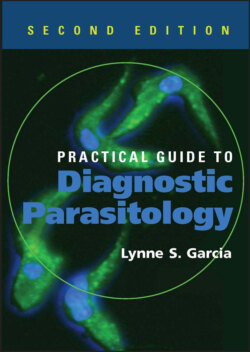Читать книгу Practical Guide to Diagnostic Parasitology - Lynne Shore Garcia - Страница 41
На сайте Литреса книга снята с продажи.
Primary Amebic Meningoencephalitis
ОглавлениеAmebic meningoencephalitis caused by N. fowleri is an acute, suppurative infection of the brain and meninges. With extremely rare exceptions, the disease is rapidly fatal in humans. The period between contact with the organism and onset of clinical symptoms such as fever, headache, and rhinitis may vary from 2 to 3 days to as long as 7 to 15 days.
The amebae may enter the nasal cavity by inhalation or aspiration of water, dust, or aerosols containing the trophozoites or cysts. The organisms then penetrate the nasal mucosa, probably through phagocytosis of the olfactory epithelium cells, and migrate via the olfactory nerves to the brain. Data suggest that N. fowleri directly ingests brain tissue by producing food cups or amebostomes, in addition to producing a contact-dependent cytolysis which is mediated by a heat-stable hemolytic protein, heat-labile cytolysis, and/or phospholipase enzymes. Cysts of N. fowleri are generally not seen in brain tissue.
Early symptoms include vague upper respiratory distress, headache, lethargy, and occasionally olfactory problems. The acute phase includes sore throat, stuffy blocked or discharging nose, and severe headache. Progressive symptoms include pyrexia, vomiting, and stiffness of the neck. Mental confusion and coma usually occur approximately 3 to 5 days prior to death. The cause of death is usually cardiorespiratory arrest and pulmonary edema.
PAM can resemble acute purulent bacterial meningitis, and these conditions may be difficult to differentiate, particularly in the early stages. The CSF may have a predominantly polymorphonuclear leukocytosis, increased protein concentration, and decreased glucose concentration like that seen with bacterial meningitis. Unfortunately, if the CSF Gram stain is interpreted incorrectly (identification of bacteria as a false positive), the resulting antibacterial therapy has no impact on the amebae and the patient usually dies within several days.
Extensive tissue damage occurs along the path of amebic invasion; the nasopharyngeal mucosa shows ulceration, and the olfactory nerves are inflamed and necrotic. Hemorrhagic necrosis is concentrated in the region of the olfactory bulbs and the base of the brain. Organisms can be found in the meninges, perivascular spaces, and sanguinopurulent exudates.
Clinical and laboratory data usually cannot be used to differentiate pyogenic meningitis from PAM, so the diagnosis may have to be reached by a process of elimination. A high index of suspicion is often mandatory for early diagnosis. All aspects of diagnostic testing (specimen collection, processing, examination, and reporting) should be considered STAT. Although most cases are associated with exposure to contaminated water through swimming or bathing, this is not always the case. The rapidly fatal course of 3 to 6 days after the beginning of symptoms (with an incubation period of 1 day to 2 weeks) requires early diagnosis and immediate chemotherapy if the patient is to survive.
Analysis of the CSF shows decreased glucose and increased protein concentrations. Leukocyte counts may range from several hundred to >20,000 cells per mm3. Gram stains and bacterial cultures of CSF are negative; however, the Gram stain background can incorrectly be identified as bacteria, thus leading to incorrect therapy for the patient.
A definitive diagnosis could be made by demonstration of the amebae in the CSF or in biopsy specimens. Either CSF or sedimented CSF should be placed on a slide under a coverslip and observed for motile trophozoites; smears can also be stained with Wright’s or Giemsa stain. CSF, exudate, or tissue fragments can be examined by light microscopy or phase-contrast microscopy. Care must be taken not to mistake leukocytes for actual organisms or vice versa. It is very easy to confuse leukocytes and amebae, particularly when one is examining CSF by using a counting chamber, hence the recommendation to use just a regular slide and coverslip. Motility may vary, so the main differential characteristic is the spherical nucleus with a large karyosome.
Specimens should never be refrigerated prior to examination. When centrifuging the CSF, low speeds (250 × g) should be used so that the trophozoites are not damaged. Although bright-field microscopy with reduced light is acceptable, phase microscopy, if available, is recommended. Use of smears stained with Giemsa or Wright’s stain or a Giemsa-Wright’s stain combination can also be helpful. If N. fowleri is the causative agent, only trophozoites are normally seen. If the infecting organism is Acanthamoeba spp., cysts may also be seen in specimens from individuals with central nervous system (CNS) infection. Unfortunately, most cases are diagnosed at autopsy; confirmation of these tissue findings must include culture and/or special staining with monoclonal reagents in indirect fluorescent-antibody procedures. Organisms can also be cultured on non-nutrient agar plated with Escherichia coli.
In cases of presumptive pyogenic meningitis in which no bacteria are identified in the CSF, the computed tomography appearance of basal arachnoiditis (obliteration of basal cisterns in the precontrast scan with marked enhancement after the administration of intravenous contrast medium) should alert the staff to the possibility of acute PAM.
The amebae can be identified in histologic preparations by indirect immunofluorescence and immunoperoxidase techniques. The organism in tissue sections looks very much like an Iodamoeba bütschlii trophozoite, with a very large karyosome and no peripheral nuclear chromatin; the organisms can also be seen with routine histologic stains.
